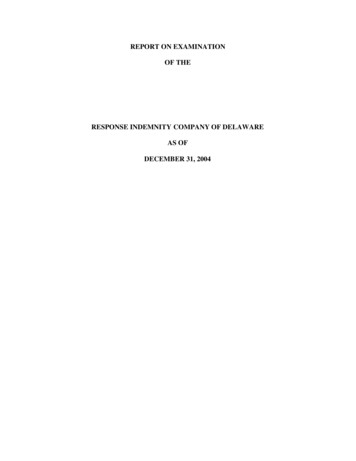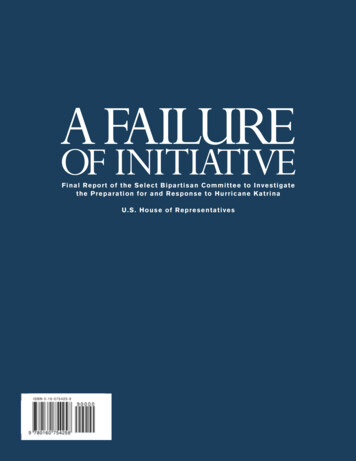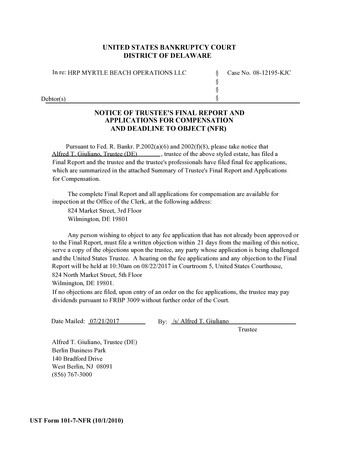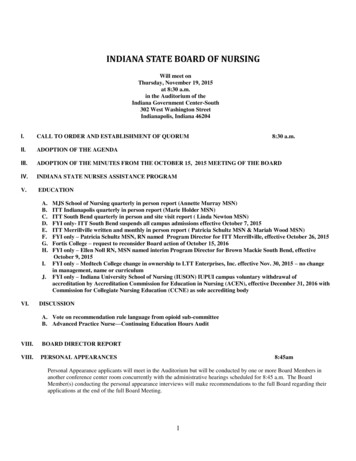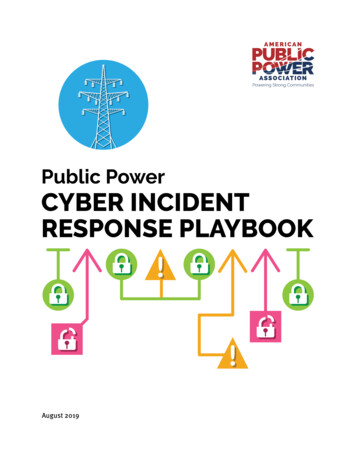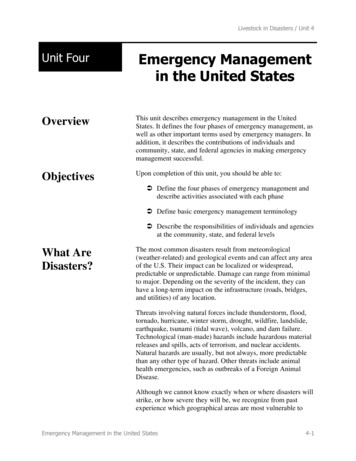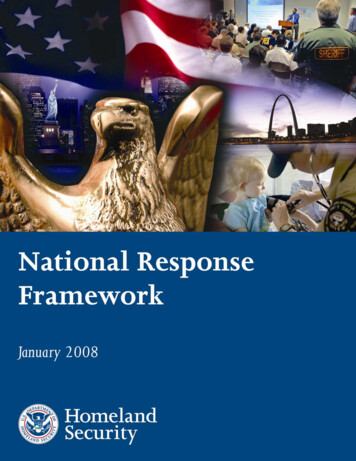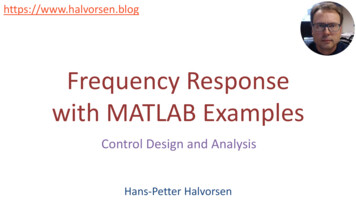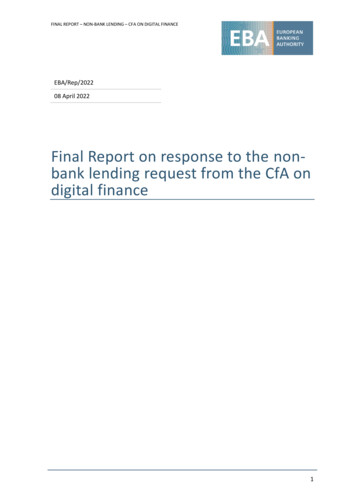
Transcription
FINAL REPORT – NON-BANK LENDING – CFA ON DIGITAL FINANCEEBA/Rep/202208 April 2022Final Report on response to the nonbank lending request from the CfA ondigital finance1
FINAL REPORT – NON-BANK LENDING – CFA ON DIGITAL FINANCEContentsFinal Report on response to the non-bank lending request from the CfA on digital finance1List of figures, tables and text boxes4Executive Summary51. Introduction92. Scope of the analysis113. Market developments and trends133.1Global trends in FinTech and BigTech lending133.2BigTech lending in the EU163.3FinTech lending in the EU173.4Other non-bank lenders in the EU193.5Lending in crypto-assets204. Legislative framework244.1Bank lending and exceptions included in the CRD244.2EU legislation applicable to non-bank lending providers255. Non-bank lending at national level265.1A mapping of business models for non-bank lending265.2Authorisation and registration at national level285.3Regulatory approach to non-bank lending at national level336. Business models and regulatory regimes for non-bank lending366.1Peer-to-peer (P2P) lending platforms / marketplace lending376.2Buy-Now-Pay-Later (BNPL)416.3Microcredit436.4Pawnshops456.5Financial leasing466.6Factoring476.7Balance sheet lending496.8Applicability of AML/CTF rules to non-bank lenders517. Key risks and regulatory/supervisory issues537.1Prudential aspects and supervision537.2Consumer protection / conduct of business rules587.3ML/TF risks647.4Macroprudential risks657.5Microprudential risks662
FINAL REPORT – NON-BANK LENDING – CFA ON DIGITAL FINANCE8. Policy proposals698.1Prudential supervision698.2Consumer protection and conduct of business738.3AML/CTF aspects778.4Macroprudential risks788.5Microprudential risks79Annex I82Annex II – Lending by payment institutions and e-money institutions87Annex III913
FINAL REPORT – NON-BANK LENDING – CFA ON DIGITAL FINANCEList of figures, tables and text boxesFigure 1. Fintech and Bigtech credit, at global level . 14Figure 2. Fintech and BigTech, lending volume and share of total lending . 14Figure 3. Euro area FCLs assets (LHS) and liabilities (RHS), EUR/bn. 20Figure 4. Illustrative business models of decentralized crypto-asset lending platforms . 22Table 1. Volume of digital lending (mn/EUR) in the EU, breakdown by business models. 17Table 2. Volume of FinTech lending (mn/EUR) in the EU, breakdown by Member States . 18Table 3. Mapping of business models for non-bank lending in the EU . 27Table 4. Overview of authorisation and registration regimes for non-bank lenders across the EU 29Table 5. Provision of non-bank lending services not explicitly subject to authorisation/registration. 32Table 6. Overview of national regulatory regimes for non-bank lending in the EU . 34Table 7. Examples of regulatory requirements for P2P/marketplace consumer lending . 39Table 8. Examples of regulatory requirements applicable to microcredit. 44Table 9. Examples of regulatory requirements applicable to pawnshops* . 45Table 10. Examples of regulatory requirements applicable to financial leasing . 47Table 11. Regulatory requirements applicable to factoring . 49Table 12. Examples of regulatory requirements applicable to balance sheet consumer lending . 50Table 13. Examples of regulatory requirements applicable to balance sheet business lending . 50Table 14. Examples of regulatory requirements applicable to balance sheet mortgage lending . 51Box 1. Key market developments in P2P/marketplace lending (secondary market for loans) . 39Box 2. Key market developments in BNPL . 424
FINAL REPORT – NON-BANK LENDING – CFA ON DIGITAL FINANCEExecutive SummaryIn February 2021, the European Commission published its Call for Advice on digital finance andrelated issues1, requesting the European Supervisory Authorities (ESAs) to carry out an analysis ofthe fragmentation of the financial services value chain, the growth of digital platforms and mixedactivities groups and to prepare recommendations so that the EU regulatory framework remains fitfor purpose. The Joint ESA Response to the Call for Advice was submitted to the Commission inJanuary 2022.2 As part of the Call for Advice, the EBA was specifically asked to carry out an analysisof the non-bank lending sector, i.e. lending provided by financial intermediaries outside the EUfinancial services regulatory perimeter, with the aim of identifying the relevant risks and the extentto which these activities are not covered by EU legislation. In particular, the EBA was requested toadvise on the potential need to adjust the EU regulatory perimeter, developing and proposingappropriate policy options. This report sets out the findings and advice of the EBA in response tothe Commission’s request.Credit intermediation by companies that are not banks is not new, and some business models areindeed well established. However, the use of new technologies and the digitalisation of financialservices are leading new players to enter local EU markets. To this extent, the provision ofinnovative financial services may bring benefits for consumers and increase competition in themarket, but when credit provision happens outside the EU regulatory perimeter, this may createchallenges for all the stakeholders and regulators as well. While data3 show that the magnitude ofnon-bank lending remains very small compared to credit provided by banks, FinTech 4 has beenincreasing quite steadily over the last years and the trends observed outside the EU show thatBigTechs and other non-traditional operators have already developed and successfully rolled outbusiness models for lending. The same applies to lending in the form of crypto-assets, an area whichhas seen a rapid increase since 2020 (albeit in relative terms still de minimis) and that hascontributed to the extension and reach of non-bank lending activities in alternative means otherthan conventional fiat funds. Overall, some existing data suggest that crypto-asset lending activitiesin the EU are growing but are still limited in terms of observed volumes and values. However, thisreport analyses the different formats in which crypto-asset lending and borrowing activities canhappen, including in decentralised form, and gives consideration to activities such as ‘staking’ and‘crowdlending’.5The analysis of the regulatory regimes currently in place – based on a survey conducted amongcompetent authorities (CAs), as well as other EBA and Joint Committee reports – shows that non1European Commission (2021), Request to EBA, EIOPA and ESMA for technical advice on digital finance and related issues,Ref. Ares(2021)898555, 02 February.2ESAs (2022), The ESAs recommend actions to ensure the EU’s regulatory and supervisory framework remains fit-forpurpose in the digital age, response to the Call for Advice on digital finance, EBA website.3See Section 3.3, based on the data by the Cambridge Centre of Alternative Finance (CCAF).4‘FinTech’ and ‘Bigtech’ as defined in Section 2 of the Report.5See Section 3.5 for the definition of crowdlending.5
FINAL REPORT – NON-BANK LENDING – CFA ON DIGITAL FINANCEbank lending remains largely unharmonised across the EU: in some cases, a specific authorisationor registration is needed to carry out lending activities, and entity-based requirements are applied;in other cases, there are no entity-based requirements but only activity-based ones, while in someother cases the activities may be unregulated and there may not be prudential or business conductrequirements applicable. The report also provides an overview of the presence of certain businessmodels (P2P crowdfunding, Buy-Now-Pay-Later, pawnshops, leasing, factoring, balance sheetlending) across different Member States (MS) and examples of the relevant applicable regulatoryframework. This also shows quite a wide variety of approaches among the regulatory regimes fornon-bank lending across the EU as previously identified in the EBA’s report on other financialintermediaries and regulatory perimeter issues. 6 In addition, the report identifies those areaswhere specific risks have been detected and puts forward some proposals to address them.The first area relates to the prudential perimeter and supervision of non-bank lenders. Firstly,where non-bank lenders are not subject to any entity-specific requirements, the only applicableprovisions are the ones foreseen at activity level and included in the Consumer Credit Directive(CCD) and in the Mortgage Credit Directive (MCD). As these may be the only requirements that willenable authorities to conduct supervision on these firms, it is proposed to strengthen the provisionsin terms of authorisation and admission to activities, so to allow effective oversight. Secondly, theincreased use of digital means (including digital platforms) to distribute financial products andservices is fuelling provision of services on a cross-border basis. However, allocation ofresponsibilities between home and host supervisors remains often unclear and it may be difficultto identify which competent authority is responsible for supervising how the service is provided.Therefore, it is proposed that more clarity should be provided in the identification of theresponsibilities of the home and host supervisory authorities regarding the provision of crossborder non-bank lending, and the respective competences.Thirdly, in line with the findings of the response to the CfA on digital finance, the report observesthat the lack of clarity in the Capital Requirements Regulation (CRR) definition of ‘ancillary servicesundertaking’ (ASU) and the limitations in the definition of ‘financial holding company’ may leaveroom to the risk of regulatory arbitrage and reduce the effectiveness of the current consolidationframework in capturing emerging risks in groups that include non-bank lending entities. It istherefore proposed that the definition of ‘financial holding company’, ‘ancillary servicesundertaking’ and ‘financial institution’ can be modified to close existing loopholes with regard toprudential consolidation. In this regard, the EBA welcomes the Commission’s recent proposal torevise the CRR definitions that are relevant for the purposes of the application of the bankconsolidation framework under the CRD/CRR. Moreover, in accordance with the recommendationsof the response to the Call for Advice on digital finance, it is proposed that a cross-sectoral ‘gapanalysis’ is carried out as regards the scope of application of existing prudential consolidation ruleswith respect to different types of group structures across the financial sector.A second area where risks have been identified and proposals put forward relates to the need ofensuring that the consumer protection framework remains fit for purpose also with respect to6EBA (2017), Report on other financial intermediaries and regulatory perimeter issues.6
FINAL REPORT – NON-BANK LENDING – CFA ON DIGITAL FINANCEentrance in the market of new players. Firstly, the current scope of the CCD provides for someexemptions that expressly exclude (or do not include) some of the business models that havebecome progressively more relevant for non-bank lending (e.g. Buy-Now-Pay-Later). It is thenproposed to retain the current Commission proposal amending the CCD so as to cover those entitiescurrently outside its scope. This will allow better oversight for those fast-growing and innovativefirms that recently entered the market and provide adequate tools for consumer protection.Secondly, in order for consumers to make informed decisions about financial products and services,they must have access to high-quality, clear and easily accessible information explaining thefeatures and costs across the lifetime of the products and services. While the CCD and MCDcurrently already include provisions on advertising requirements and pre-contractual information,the growing use of distance marketing might negatively affect the customer’s understanding ofcredit products, limiting their awareness of the key elements and costs of the credit product theyare buying, because the information requirements are not adapted to digital tools. Thus, it isproposed to enhance the disclosure requirements and ensure that they are fair, effective and wellsuited to new forms of lending and more innovative business models. Finally, it is recognised thata robust assessment of creditworthiness is instrumental in protecting consumers from the risk ofentering into financial agreements they cannot afford to repay, thus increasing the risk of overindebtedness. Therefore, it is proposed to strengthen the requirements for creditworthinessassessment and ensure that it is conducted also in the interest of consumers, in particular wheninnovatory artificial intelligence (AI) tools are used. As these proposals are largely addressed in thecurrent version of the CCD review put forward by the Commission, it is proposed to retain theseamendments and possibly strengthen them.A third area where some concerns have been highlighted relates to AML/CFT risks. Not all providersof the activities explored in this Report are in the scope of concept of ‘obliged entities’ in Directive(EU) 2015/849 (AMLD), which refers to the list in Annex I of the CRD. Therefore, these providers donot need to be authorised or licensed under the CRD or other sectoral laws unless they areauthorised or licensed as a result of their wider financial activities, or are covered by national rules.As a consequence, when no authorisation or licensing regime is in place for certain non-banklending activities, these may not be subject to AML/CTF requirements. It is therefore proposed tocover all non-bank lenders in a more comprehensive way in the EU-wide AML/CTF framework, toensure greater harmonisation and that such entities are captured as ‘obliged entities’.Finally, in consideration of the potential for a quick build-up of these risks competent authoritieshave expressed the need of having more visibility on the risks that activities of non-bank lendersmay entail for financial stability, in particular when the provision of services is carried out on across-border basis. It was recognised that these risks need to be monitored closely to avoid thatany sudden increase will remain unaddressed, in the context of several non-bank lenders movingfast and at the same time. Therefore, it is proposed to consider the set-up of a standardisedreporting infrastructure at EU level (possibly leveraging on, and avoiding overlaps with, existingmonitoring tools), to enable an appropriate mapping and obtain one integrated overview ofmacroprudential risks and vulnerabilities. In addition, it is also proposed to consider the possibilityof an introduction of activity-based macroprudential measures to cover all credit providers, based7
FINAL REPORT – NON-BANK LENDING – CFA ON DIGITAL FINANCEon a minimum harmonisation of the tools that are already widely applied across the EU. Similarly,with regard to microprudential risks, it is also proposed to consider the benefits and costs ofminimum common requirements for non-bank lenders to enhance the resilience of the nonbanking sector, ensure the continuity of the financing of the EU economy and provide moreprotection to consumers.8
FINAL REPORT – NON-BANK LENDING – CFA ON DIGITAL FINANCE1. Introduction1. The digital finance strategy7 adopted in September 2020 set out the European Commission’sintention to review the existing financial services legislative frameworks with the aim ofprotecting consumers, safeguarding financial stability and the integrity of the EU financialsector and ensuring a level playing field.2. To prepare these actions, in February 2021 the Commission published its Call for Advice ondigital finance and related issues, 8 requesting advice from the European SupervisoryAuthorities (ESAs) on how to address ‘same activity, same risk, same rules’ issues, morefragmented value chains and the scope of supervisory perimeters. 9 In addition, theCommission issued to the EBA a specific Call for Advice on how to address the prudential risksrelated to non-bank lending.3. The regular monitoring of credit intermediation activities outside the traditional bankingsystem has been recognised by policymakers at both international and EU levels as essentialto ensure that risks to financial stability emerging outside the perimeter of banking regulationare identified and addressed appropriately.4. According to Article 16a(1) of Regulation (EU) 2010/1093 (EBA Founding Regulation), the EBAmay, upon a request from the European Parliament, from the Council or from the Commission,or on its own initiative, provide opinions to the European Parliament, the Council and theCommission on all issues related to its area of competence. Based on this provision, the EBA istherefore competent to analyse the current regulatory landscape in place in the EU for nonbank lending and analyse the related risks, and propose recommendations,5. As part of the Commission’s Call for Advice on digital finance, the EBA is carrying out an analysisof non-bank lending. In particular, the EBA is requested to:a. examine to what extent non-bank lending, provided by financial intermediariesoutside of the pan-European financial services regulatory perimeter including asapplicable by technology companies and digital platforms, exists in the EU and mayevolve/scale up, recognising the deployment of innovative technologies, as well asreport on the business models and legal structures employed;b. analyse national rules in place to regulate these activities across the EU;c. assess to what extent these activities are covered by other EU legislation (e.g.Consumer Credit Directive and Mortgage Credit Directive);7European Commission (2020), Digital Finance Strategy for the EU, COM/2020/591, 24 September.8See footnote 1.9See Joint Committee of the ESAs (2022), Joint ESA response to the European Commission’s February 2021 Call for Adviceon digital finance and related issues, ESA 2022 01, January.9
FINAL REPORT – NON-BANK LENDING – CFA ON DIGITAL FINANCEd. identify any regulatory and supervisory issues that may impede micro/macro riskmanagement and scaling up of services on a cross-border basis;e. advise on any potential need to adjust the EU regulatory perimeter to addressidentified issues.6. To inform this work, the EBA launched a survey among competent authorities to gatherrelevant information about entities carrying out non-bank lending in their jurisdictions. Inparticular, the survey collected information on the presence of certain business modelswhereby lending activities were carried out by non-bank entities, and any regulatoryrequirements that are applicable at local level. Furthermore, the survey collected the views ofsupervisors on the risks currently posed by non-bank lending activities in the EU.7. Accordingly, after the definition of the scope of the analysis in Section 2, the structure of thereport provides in Section 3 a brief overview of the most recent trends and marketdevelopments both in the EU and outside the EU on lending provided by non-bank entitieswith a particular focus on BigTechs and FinTechs. Section 4 outlines the EU legislativeframework, while Sections 5 and 6 summarise the results of the survey conducted atcompetent authorities in terms of business models and applicable regulatory frameworks,respectively. Finally, Section 7 illustrates the main issues identified in the area of supervisionand scope of prudential regulation, consumer protection, AML/CFT, macroprudential andmicroprudential risks, while Section 8 concludes by putting forward some proposals for therisks identified in these areas.10
FINAL REPORT – NON-BANK LENDING – CFA ON DIGITAL FINANCE2. Scope of the analysis8. For the purpose of this Report, the analysis on non-bank lending in the EU covers entitieswhich:a. are established in the EU;b. carry out, as a creditor or peer-to-peer (P2P) lending platform, one or more creditintermediation activities, which are:i. maturity transformation (borrowing over the short term and lending/investing onlonger timescales);ii. liquidity transformation (using cash-like liabilities to buy less liquid assets);iii. leverage;iv. credit risk transfer (transferring the risk of credit default to another person for a fee);v. similar activities;c. are not subject to entity-specific (i.e. solo) prudential requirements under the followingpieces of the EU sectoral legislation10:i. CRR/CRD11;ii. ECSPR (Regulation (EU) 2020/1503 on European crowdfunding service providers forbusiness);iii. AIFMD (Directive 2011/61/EU on alternative investment fund managers);iv. UCITS (Directive 2009/65/EC on undertakings for collective investment in transferablesecurities);v. MMF Regulation (Regulation (EU) 2017/1131 on money market funds);vi. Regulation (EU) 2015/760 (European long-term investment funds);vii. Regulation (EU) 346/2013 (qualifying social entrepreneurship funds);viii. Regulation (EU) 345/2013 (qualifying venture capital funds);ix. Regulation (EU) No 648/2012 on OTC derivatives, central counterparties and traderepositories;x. IFR (Regulation (EU) 2019/2033 on prudential requirements of investment firms);xi. IFD (Directive (EU) 2019/2034 on prudential requirements and prudential supervisionof investment firms);10To note that the scope of the present Report differs from the scope that is relevant for the identification of shadowbanking entities as defined in EBA (2021), Draft RTS on criteria for the identification of shadow banking entities underArticle 394(4) of Regulation (EU) No 575/2013, EBA/CP/2021/30, July.11Entities that are exempted from the CRD/CRR on the basis of Article 2(5) CRD are also outside the scope of this survey.11
FINAL REPORT – NON-BANK LENDING – CFA ON DIGITAL FINANCExii. MIFIR (Regulation (EU) No 600/2014 on markets in financial instruments);xiii. MIFID II (Directive 2014/65/EU on markets in financial instruments); Solvency II(Directive 2009/138/EC on insurance and reinsurance);xiv. Directive (EU) 2016/2341 on the activities and supervision of institutions foroccupational retirement provision (IORPs);xv. STS (Regulation (EU) 2017/2402 on simple, transparent and standardisedsecuritisation);xvi. PSD212 (Second Directive (EU) 2015/2366 on payment services);xvii. EMD2 (E-money Directive, Directive 2009/110/EC on electronic money institutions).9. Non-bank lending providers that do not fall under any EU sectoral regulations listed abovebut offer financial products that are subject to the EU activity-based regulations (e.g. CCDand MCD) were also included in the scope of the analysis.10.For the purpose of this Report, the analysis of non-bank lending providers covers thefollowing types of entities: ‘BigTech’ – large technology companies with extensive customer networks; they includefirms with core businesses in social media, internet search, software, online retail andtelecoms13; ‘FinTech’ – technology-enabled innovative firms operating in the areas of financial servicesthat could result in new business models, applications, processes or products14; ‘Other non-bank lenders’ – entities providing non-bank lending that are not BigTech orFinTech firms.11.Finally, the scope of the current analysis is narrower than the one included in the ESRBwork 15 on monitoring of the EU non-bank financial intermediation (NBFI), as it coversmainly entities classified by the ESRB as financial corporations engaged in lending, whichconstitute a subsection of other financial intermediaries (OFIs).1612Observation of the market has however revealed that non-bank lending is often provided by innovative tech entitieswhich, at times, operate under the licence of a payment institution or an electronic money institution. The Report thensought to take into account in its analysis this specific configuration of the market, where relevant (see Annex II).13This definition builds on the list of companies included in Crisanto, J. C., Ehrentraud, J. and Fabian, M. (2021), Big techsin finance: regulatory approaches and policy options, FSI Briefs No 12, March.14This is a general definition of FinTech which covers financial innovations emerging in many aspects of finance – retailand wholesale, payments, financial market infrastructures, investment management, insurance, credit provision andequity capital markets. To this extent, the EBA analysis of non-bank lending focuses only on FinTech-enabled creditprovision. Also, ‘FinTech credit refers to credit activity facilitated by electronic platforms. This usually involves borrowersbeing matched directly with investors, although some platforms use their own balance sheet to lend. FinTech platformsfacilitate various forms of credit, including consumer, business and property lending, as well as debt funding such asinvoice financing.’ (FSB & BIS (2017), FinTech credit: Market structure, business models and financial stabilityimplications).15ESRB (2021), NBFI Monitor No 6, EU Non-bank Financial Intermediation Risk Monitor 2021, August.16However, it is worth underlining that the National Financial Accounts, which form the basis for the NBFI datamonitoring, do largely capture FinTech credit activities (FSB (2019), Global Monitoring Report on Non-Bank FinancialIntermediation 2018, Section 5.1, Case Study on Fintech credit: Data, classification and policies, pp. 68-72, 4 February).12
FINAL REPORT – NON-BANK LENDING – CFA ON DIGITAL FINANCE3. Market developments and trends12.Banks and traditional non-bank lenders remain the main providers of credit in Europe. However,over the last decade the credit market has been characterised by a significant transformation,led by the increasing digitalisation of services, so that new credit intermediaries have emerged.In particular, new lending models facilitated by online platforms have become more widespread,both through provision of services by FinTech firms (e.g. via P2P/marketplace lendingplatforms), and by other digital platforms enabling balance sheet lending and invoice trading.Moreover, over the past few years large technology companies (BigTechs) have also startedentering credit markets in partnership with banks, leveraging on their extensive user base, whichfacilitates the process of onboarding borrowers. Moreover, BigTechs can use large-scale microlevel data on users, often obtained from non-financial activities, to measure borrowers’creditworthiness and to market targeted financial products to consumers.13.As much of the growth experienced by BigTech and FinTech in the credit market has occurredover recent years, consistent and standardised data on non-bank lending enabling comparisonsacross various EU jurisdictions17 are not yet available and formal reporting obligations may existonly when one of these entities is part of a regulated financial group; supervisors and regulatorsmust often rely on non-official sources18.14. The following sections provide an overview of recent market developments and trends in nonbank lending both at global level and within the EU. The analysis of the latter is based onresponses to the EBA survey on non-bank lending conducted for this Report and on the EBAReport on digital platforms19. This analysis is also supplemented by information from externalsources, including inter alia: the BIS analysis on FinTech and BigTech credit20, the CambridgeCentre for Alternative Finance (CCAF) global alternative finance database on FinTech credit andthe ESRB report on EU Non-bank Financial Intermediation Risk Monitoring21.3.1 Global trends in FinTech and BigTech lending15. Data recently published in a BIS Working Paper22 show a significant increase in lending volumesprovided by FinTech and BigTech players at global level between 2013 and 2019, sometimesthanks to partnerships established with traditional financial institutions; the data also show that,since 2018, BigTech credit has overtaken FinTech credit in total size (see Figure 1).17Annex 1 to this Report provides some data on non-bank lending, collected from EU competent authorities.18The scarcity of reliable data on FinTech and BigTech credit has also been acknowledged by Cornelli, G., Frost, J.,Gambacorta, L., Rau, R., Wardrop, R. and Ziegler, T. (2020), Fintech and big tech credit: a new database, BIS WorkingPapers No 887, 22 September.19EBA (2021), Report on the use of digital platforms in the EU banking and payments sector, EBA/REP/2021/26.20See reference in footnote 18.21ESRB (2021), NBFI Monitor No 6, EU Non-bank Financial Intermediation Risk Monitor 2021, August.22Cornelli, G., Frost, J., Gambacorta, L., Rau, R., Wardrop, R. and Ziegler, T. (2020), Fintech and big tech credit: a newdatabase, BIS Working Papers No 887, 22 September.13
FINAL REPORT – NON-BANK LENDING – CFA ON DIGITAL FINANCEFigure 1. FinTech and BigTech credit, at global levelSource: Cornelli, G., Frost, J., Gambacorta, L., Rau, R., Wardrop, R. and Ziegler, T., Fintech and big tech credit:a new database, BIS Working Papers, No 887, September 2020, p. 6.Note: 2020 figures are provisional.16. BIS data show that over recent years BigTech lending growth was particularly strong in Asia(China, Japan, Korea and Southeast Asia), and some countries in Africa and Latin America. GlobalFinTech credit volumes declined in 2018–19 mainly due to some market and regulatoryd
FINAL REPORT - NON-BANK LENDING - CFA ON DIGITAL FINANCE 2 ontents Final Report on response to the non-bank lending request from the CfA on digital finance 1 List of figures, tables and text boxes 4 Executive Summary 5 1. Introduction 9 2. Scope of the analysis 11 3. Market developments and trends 13
